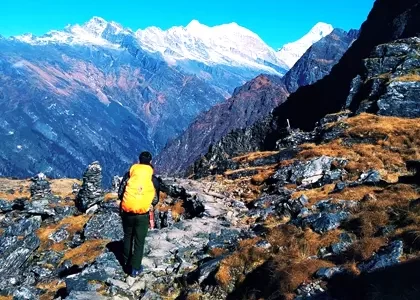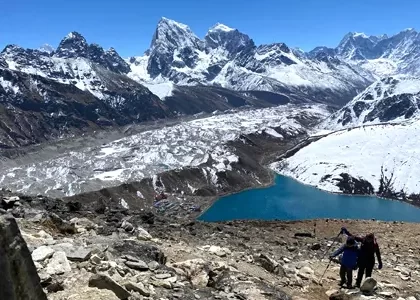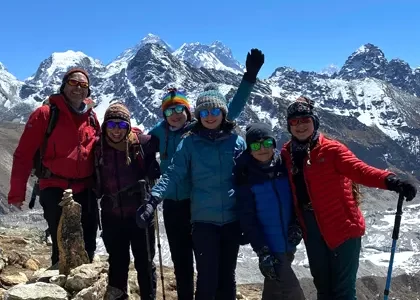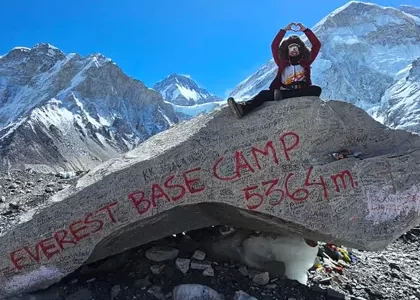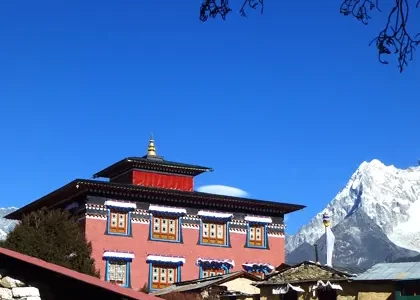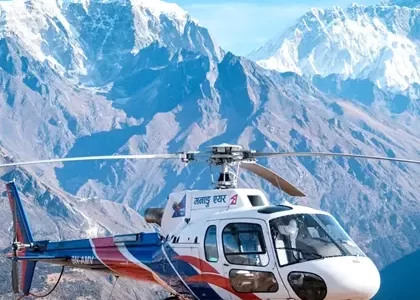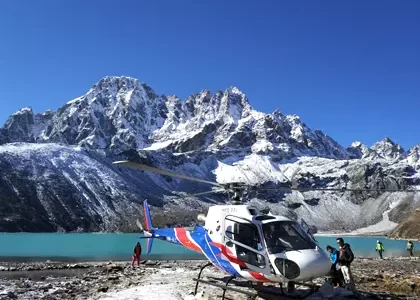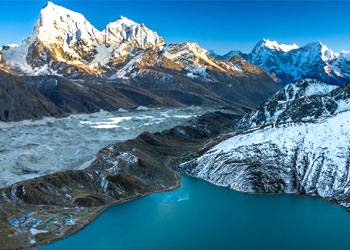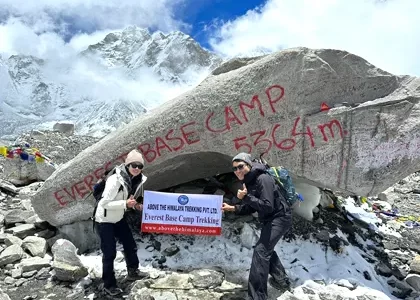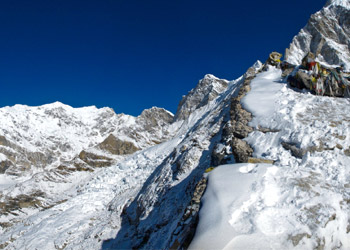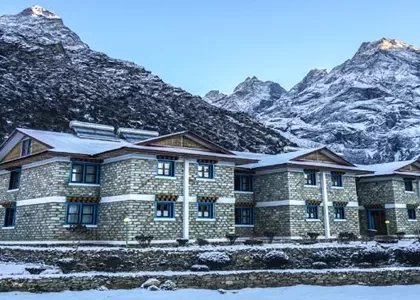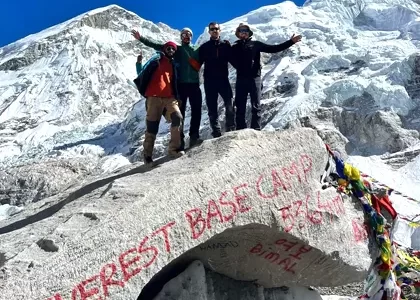Everest Region Trek
The Everest region trek takes you to Everest’s most iconic base camp. It is all at the foot of the highest mountain in the world, Mount Everest (8848m). This Everest region trek is one of the world’s classic treks. This attracts tourists every year.
The Everest Base Camp area lies in Solukhumbu District. The site is an excellent location for trekking due to the highest peak, Mt. Everest (8848m). Solukhumbu is the place of origin for the inborn mountaineers or sherpas.
Their specific traditional lifestyle and practices make trekking unique. The ethnic stone-housed villages and their sound hospitality will make your trek unforgettable. We will walk through Shrepa’s land, which has Buddhist monuments of stupas. We will also shorten mani partitions and gompas with a spiritual experience.
Get the best trekking experience.
The Everest region trek is a journey through Namche Bazaar. We start from Lukla and rest at Mysterious Kala Patthar. The whole Solukhumbu vicinity sits in the lap of looming Mt. Everest. Those who took on the challenge of conquering this region can expect the most majestic views.
Enjoy the mountain peaks, the Dudh Koshi River’s scenic beauty, and the area’s incredible natural scenery. The vicinity of the world’s highest mountain range will make you feel like you’re on top of the world.
Walking through the Everest region trek, you will get a once-in-a-lifetime chance to experience it. You will trek in a lush flora of deciduous forests and scattered rice terrace fields. We will pass by majestic pine forests and blooming rhododendrons. In the spring season, there is the colorfulness of thousands of flowers.
Why visit the Everest region trek
This area of the Everest region trek has the most exotic fauna. We will trek in Sagarmatha National Park. You can keep your eyes open for Himalayan Tahr, musk deer Pikka, and mouse hare. Above you, in the sky, you might search for the golden eagle.
We will see the pinnacle-notch Himalayan Monal: the Daphe, the Nation bird of Nepal. The Everest Khumbu area is also home to leopards and snow leopards. It is also famous for its allegedly fearsome Yeti.
Most of the Everest region trek starts by flying to Lukla. You can go to Everest base camp (EBC) or the sacred lakes at Gokyo. But, these days, only some trekkers take the route of the roadway at Jiri.
You may explore the local and concrete villages via Jiri or Hile to EBC. You will experience the breathtaking views of the world’s tallest, Mt. Everest, and a stunning view of Ama Dablam, Taweche, Thamserku, Mt. Makalu, and Mt. Lhotse.
Everest region trek highlights
Mt Everest and several other peaks
The world’s highest peak, Mt. Everest(8848m), lies in this region. Although the base camp trek does not involve climbing the highest peak, it does offer a panoramic view of the mountain.
Not only this, but there are other peaks in this region. While on the way, you will see Mt. Makalu (8,463m), Mt. Cho Oyo (8153m), Mt. Lhotse (8,501m), and Mt. Lhotse Shar (8,393m). For those who prefer visiting the mountain, EBC is worth trekking.
Sherpa Culture
The legendary Sherpas populate the Everest region trek. The lifestyle, culture, tradition, and speaking are distinct from others in Nepal. How they treat and welcome their guests is the perfect thing you will see on Everest. Likewise, with a different lifestyle, you will even find the diverse taste of food made by Sherpa’s. Such a journey is well worth doing.
Photographs of Everest
If you are on the Everest region trek, then it is obvious that you will watch Mt. Everest closely and get the chance to take photographs from nearby. On the way to EBC, several other mountains and natural views will add spice to your journey.
Monasteries and Museum
Most of the monasteries in the Everest region are uphill, from where you can see the mountains. The monasteries in Everest are spiritual and cultural. There is a Sherpa museum called Sagarmatha National Park Museum. Here, you can visit and learn about the ancient history of Sherpas.
Making new friends
As already said, the Everest Base Camp Trek is famous, so many people visit the area. It is the best trek if you are fond of making new friends. Here, you will find many people of different nationalities and cultures.
Prayer Flags
If you are on the Everest region trek, prayer flags are the most common thing you will see on your way. A prayer flag is a rectangular one made of clothes with prayer letters. The view with prayer flags is astonishing to watch. You will love the way it looks there.
Everest Base Camp trek, Gokyo Lake trek, Ebc Chola pass trek, Everest view trek. Other famous tours of the Everest region trek exist. Among all Nepal’s excellent treks, the Everest region trek is one of the most memorable.
You will get the opportunity to experience high-altitude mountain scenery. You will see a traditional lifestyle. You will enjoy several natural wonders of this heavenly country, Nepal.
Facts about the Mt. Everest region trek
World’s tallest mountain with a height of 8828 meters.
About 4000 people are on the list of people attempting Mount Everest climbing.
The total number of people who have climbed Mount Everest is 660
The total number of people who died trying to climb Mount Everest is 142
It lies in the part of the Himalayan mountain range between the Tibet and Nepal border.
Location: part of the Himalayan mountain range. It straddles the border of Nepal and Tibet.
Sir George Everest, a British surveyor-general of India, named it.
Age: almost 60 million years old.
Chomolungma is the Tibetan name for “Mother Goddess of the Earth.”
Nepal, India, and Tibet are the countries that were visible at the summit.
Edmund Hillary and Tenzing Norgay were the first to climb Mount Everest on May 29, 1953.
Everest region treks some more highlights.
Enjoy the breathtaking view of the world’s tallest mountain – in our Everest trekking.
We are surrounded by the beauty of nature and the mountains of Nepal: Cho Oy u, Lhotse, Nuptse, Ama Dablam, Makalu, and so on.
Experience the hospitality of the Sherpa people. Learn about their community, traditions, and culture.
Ge the spiritual experience by visiting the Tengboche Monastery.
Enjoy tea or coffee at the world’s highest-placed Everest View Hotel.
Discover the beauty of Sagarmatha National Park. It is home to several species of endangered animals.
Enjoy the 360-degree view from Kala Patthar. You will see pictures of Mount Everest, Makalu, Lhotse, and many other peaks.
These are the most exciting and adventurous flights to/from Lukla.
Take a guided city tour of Nepal’s UNESCO-listed World Heritage Sites.
How to reach the Everest region trek
The Everest region trek is in northeastern Nepal. Due to its high altitude and Himalayan regions, most higher areas have lots of snow. A thrilling plane ride to Lukla is the only way to reach this region. During the season, you start from Tribhuvan International Airport or Manthali Airport.
The small valley of Lukla is busy in the season. We will start most of the trekking adventures on Mount Everest trekking start. If you are looking for other alternatives, you can also drive to Jiri or Phaplu from Kathmandu. It is a one-day drive from Kathmandu that will take you to reach both destinations. From Jiri, you can then take a 4-5 day trek or drive to Phaplu and start the trek.
Some of our favorite treks in the Everest regions
Everest Base Camp Trek is one of the most famous treks in the Everest region. If you want to enjoy the essence of the Everest Region, then Everest Base Camp is the best choice. The trek takes 12 to 14 days, but short-time trekkers can use the helicopter option and make a one-week trek.
The highest altitude you will reach is Kalapatthar, at 5,554m. It is one of the best viewpoints of Mont Everest. On your trekking, you can see the sunrise and magnificent views of the high mountains.
If you are looking for a more challenging trek, there are different ones. The most famous is the Everest Three Passes Trek, also called the Everest High Pass Trek. This challenging trek in the Everest region spans 15 – 21 days. From the three high passes of Kongma La, Cho La, and Rengo La, you can enjoy a marvelous panorama of the mountains.
All these passes are above 5000 m in height. Another famous trek is the Gokyo Valley. Choose our Gokyo Lakes trek ten-day package if you have a short time. This route gives you a spectacular view of the sparkling high-altitude lakes.
There are easy and short treks in the Everest Region. You can do a 5-7-day trek around Namche Valley, Khumjung, and Khunde. Everest views trek five days; our Everest luxury trek goes to Mende. The less travel and new trek route, Pikey Peak, is also becoming popular.
Most of the short walks in the Everest region are of medium difficulty. You can choose these short treks if you have limited time. Still, you can enjoy the highest mountain view.
Best Time to Visit Everest Region Trek
The best time for the Everest region trek is in the autumn (September–December). If we choose, October and November are best. During this time, the skies are more transparent, and almost no rain, so the visibility is high. Another good time to visit is during the spring season(March-May). It is the flower-blooming season.
We also enjoy the rhododendron flowers along the trail during your Everest trekking. You can enjoy the unobstructed views of the Spectacular mountain ranges. Monsoon is not a good time to visit as the visibility is poor, and flights get canceled and delayed a lot now. In winter, it is okay to trek in the lower part as the upper part is snowing and very cold, and high passes are impossible.
Some of the side treks of the Everest region trek
Trekking from Jiri to the Upper region
One of the old trekking routes to reach Mt. Everest is the Jiri route for the Everest region trek. The Jiri Everest trekking offers Everest lowlands. It is also inspiring with its breathtaking Himalayan scenery. It is worth pointing out that the walk-in from Jiri is
It provides many benefits through gradual altitude. It is suitable for acclimatization and an exceptional experience on lower land. You get to know the countryside lifestyle of this region and its Buddhist culture.
Hospitable Sherpas populate this area of the Everest region trek. The major attraction of this area is the majestic mountains. Here are the high mountain villages, charming monasteries, and friendly people. Mount Everest’s tallest mountain is one of the highest peaks in this area. Walking in the alpine forests, glacial rivers, and fantastic rhododendron and pine forests.
This trek is the oldest route in the Everest region trek.
The trail of this Everest region trek begins from Jiri. We pass through many attractive villages on the Everest region trek.
A small number of trekkers visit these treks each year. While taking this route, you will also pass through the alpine forests. You will also pass glacial rivers and enjoy the warm hospitality of ethnic people. The best thing about trekking from Jiri is that you will pass through many villages of different ethnic groups.
Some are Tamang, Jirel, Rai, Brahmin, Chettri, and the Sherpa. While visiting the Buddhist monasteries, we can view different prayer flags. You can see Sherpa and other ethnic villages. They have simple yet affluent mountain lifestyles.
You enjoy the view, and walking in the Himalayas is quite an intense experience. Jiri Everest, Base Camp trekking, is best for acclimatizing. The trail goes higher and higher after having a rest day at Namche Bazaar. We will then visit famous activities in the Khumbu Region.
We will visit Tengboche Monastery, where trekkers can enjoy the best panoramic views. We can see some peaks on this trek, including Everest (8848m). The Cho Oyu (8152m), Lhotse (8516m), Makalu (8463m) and AmaDablam (6456m).
We also see Thamserku and many other mountains in the surrounding area. At Everest Base Camp, you will have the chance to see the spectacular Khumbu Icefall up Close.
Dudh Kunda Trek
Dudh Kunda is a lake at the front of Number Himal, known as the Milky Pond of Solu. It is also one of the best destinations in the Everest region trek. Dudh Kunda Lake trekking sits in the low region of the Everest trekking or Solu region.
Every August, an influx of Hindu and Buddhist devotees comes to perform cleansing rituals at the lake. Dudh Kunda lies in the lap of Mt. The local people venerate the sacred lake, which represents a lake of milk.
You will also enjoy panoramic Himalayan views of Everest, Mt. Number, and other Everest Himalayan ranges. Furthermore, the region of Dudh Kunda trekking gets fewer tourists. It gives a refreshing and peaceful place to try.
The locals, the natural beauty of the area, and the stunning mountain scenery will overawe you. Dudh Kunda is a cultural and nature lover trek in Nepal. The trail to Dudh Kunda Everest trekking starts at Shivalaya. It follows a spectacular, isolated ridge through dense forest.
We will head to the rocky and yak grazing pastures. The area is also remote, and you will likely meet people on this rarely-traveled trail. The Dudh Kunda trekking trail takes you through dense forests of rhododendrons. It has a variety of wild animals and birds, such as Mountain Thars. There are also Bears, leopards, jackals, etc. From Sasarbeni, we move towards Dudh Kunda.
It is a travel route than our Everest trekking.
While at the lake, walk around its shore and look for the spring. The high up on the Northeastern side is the source of the holy water. Unique and beautiful views of flora and fauna. Experience and interaction with diverse cultures of Sherpa. Khaling, Rai, Tamangs, Magar, and Gurungs make this journey a lifetime experience and achievement.
The hospitality of the locals is for the most spirit-warming occasions in the Solu Dudh Kunda area. This Everest region trek attracts anyone to remember and have a lifelong experience.
This Everest region trek trail will take you through the Pike Peak. We will pass the famous Goli Gompa to the holy Lake Dudh Kunda. Thus, it is the final destination of our trek, where we can view the fantastic lake. You can enjoy panoramic views of the Everest Himalaya range from the lake vicinity.
You can book This new, unique Dudh Kunda trekking trail with us. We provide a magnificent view of the high mountains and isolated Solu region.
Rolwaling Trek
It lies between the Everest and Langtang Himalaya ranges. It is below Gauri Shankar (7145m) and the south border of Tibet. This region lies between the Langtang range and the Everest region trek range. Rolwaling Valley trekking is one of the hard passes in Everest.
Thus, while trekking in these regions, we will meet the different popes of Khumbu. You will pass Tamang Village, with beautiful views.
This Everest region trek route has alpine lakes and hanging glaciers. We walk in moraines, high pastures, waterfalls, and an imminent view of snowy peaks in the backdrop. The Rolwaling region is also rich in biological diversity. It gives you glacial lakes, mountains, and isolated villages.
The vicinity is rich in flora and fauna, with 16 major vegetation types. There are 34 species of mammals, 16 fish, ten amphibians, eight lizards, 14 snakes, and 235 birds. The main Highlight of the Rolwaling trek is the magnificent forests, including the giant snow peak, Gaurishankar (7134m).
The TshoRolpa is an excellent ice lake. It is in the back by terminal moraine on the way during Rolwaling trekking. This Everest region trek offers a fantastic view of the high mountain ranges like Mt. Makalu and Mt. Gauri Shankar and the opinions of Pachermo and Ramdung peaks.
The trek goes via Khumbu Valley.
The trail joins the Khumbu Valley route so you can carry on to the Everest trekking. After you finish, you will return to Lukla and fly to Kathmandu. Furthermore, the Rolwaling trek allows you to Explore Diverse Vegetation. It also offers a diverse climate, topography, and many other beautiful places.
The region is very close to the Tibetan border. Here, you can see the people influenced by Tibetan culture. They have adopted Unique Culture and Tradition. People in the villages on the Everest region trek are very warm-hearted and kind.
Ama Dablam Base Camp visit
Ama Dablam Base Camp Trek is an excellent addition to the Everest region trek. You can also add an extra day to your Everest base camp trek itinerary and visit the Ama Dablam Base Camp. The base camp offers you the best views of the surrounding snowcapped peaks.
This beautiful mountain in the Himalayas is the best to see in the Everest region trek. It also has superior importance to the Sherpas in the Khumbu region. To reach Ama Dablam Base Camp, you must walk on the classic Everest Base Camp route.
Walking from Tengboche to Dingboche, you’ll come across a village called Pangboche. Here, you’ll have to spend an extra day so that you’re able to explore Ama Dablam Base Camp. Head west, instead of north, from Pangboche to reach Ama Dablam Base Camp.
A side trip from Dingboche village
As a trekker, you have two alternatives here. Either you can go for the entire Everest Base Camp trek on the Everest region trek. Also, Ama Dablam is a side trip, or you could go there and return to Lukla. This way, you can have all the fun, yet your trek still needs longer.
While you are at the base camp, it offers you the best photo opportunity. Observe the mountain, which takes you to the peak base at 4,600 meters. This trek also follows our famous trek route of base camp until Pangboche. From there, with around a two-day hike to the top, the trail turns off on its less congested path.
This trek is an excellent opportunity to learn about the traditional Sherpa lifestyle, religion, and culture. You can relish the panoramic view of the world’s towering peaks. If you’re pondering heading to Everest Trekking in Nepal, you can enjoy the serene beauty of the Himalayas.
You can visit the Amadablam Base camp trek. It is for an unforgettable excursion. Ama Dablam Base Camp Trek is one of the best options among many.
Khumbu Icefall
Khumbu Icefalls sits on the top of the Khumbu Glacier. The fast movements of the Khumbu Glacier form it. You will see the glacier between Mahalangur and the Kumbhakarna ranges. The view is spectacular in the early morning. The ice has not melted till then.
Otherwise, it will be slippery afterward. It is the Everest region trek’s deadliest and most challenging section. It is a journey in an icefall. This icefall is the critical route for our Mount Everest trekking. The mountains like Lhotse and Nuptse are its neighbors. Khumbu Icefall starts from an elevation of 4600 m and goes higher.
The Khumbu Glacier consists of Khumbu icefall. It is the first obstacle climbers face during the Mt. Everest expedition. It originates from the Khumbu Glacier. The glacier melts with the sun’s rays and flows to the point where Khumbu Icefall starts.
Due to global warming, the ice sheets are melting fast now.
Considered a shifting river of ice that melts every year is the Khumbu Icefall
Kala Patthar
Kala Patthar means ‘black rock’ in English. It stands at an impressive 5500m above sea level. It is the highest altitude reached on most of our Everest trekking routes. It lies to the south of the Himalayan range above the Gorak Shep. It overlooks the Khumbu Glacier and Everest Base Camp.
It is an incredible viewpoint of Everest, although the trek to the top, especially before sunrise, is strenuous. Prepare your body and mind; it was one of the highlights of my trip to Nepal.
Most of the trekkers on the route of Everest region trek don’t miss being here. The walk takes about 2-2.5 hours to reach the top of Kala Patthar from Gorak Shep. If you want the best sunrise view, get there before sunrise.
The top boulder on Kala Patthar is very dangerous. There’s a sheer drop on the other side, so avoiding it on your Everest region trek is best.
Things to pack:
You can take a Flashlight or headlamp, warm clothes, and water. Mountaineers who summit Everest also spend time on Kala Patthar. If you’re trekking to Everest Base Camp in May, you can see some famous climbers here.
Khumbu Glacier
The Khumbu Glacier sits in the Everest region trek. It is the Lhotse-Nuptse ridge With elevations of 4,900 m. It begins from Western Cwm and flows down through the Khumbu Valley. Afterward, melting, it drains into the Lobuche River.
This glacier is the highest of all glaciers in the world. The slow-moving ice from the glacier is in the form of a river. You can get the best view from the Kala Patthar. During our Everest region trek, we will follow the Khumbu Glacier in the final part of the trail. It is one of the more famous and often visited Himalayan glaciers. It is also the critical route for climbing Mount Everest.
Nangkartshang Peak
This peak lies in our Everest region trek village of Dingboche. It is an accessible “walkable” height in the region. It is also one more sub-peak of a higher ridge than an independent mountain. While at the top, you will see the best view of Mount Kangtega. We will also see , Ama Dablam, Nuptse, Lhotse, Makalu, Cho Oyu, Taboche.
We will have an acclimatization day in Dingboche. Acclimatization is excellent for higher places such as Kala Pattar, Everest Basecamp, or Island Peak. Climbing Nangkartshang is one way to kill one of the “rest” days and one of the most worthwhile.
It is a more straightforward ascent than some other walks up peaks in the area, and it is also a good fit for other peak climbers. It’s a great half-day excursion. Climbing Nangkartshang gives you a spectacular view of the Khumbu region as the People stay in Dingboche for rest. Thus, climbing Nangkartshang is also an exciting way to spend your rest day.
Hiking Gokyo Ri
Gokyo Peak is at the end of the Gokyo Valley of the Everest region trek in the Khumbu region of Nepal. It is a short day-side trip from Gokyo Lake. You will hike to the top of Gokyo Ri Mountain and the Gokyo Valley. We will explore this region’s calm and lively settlements during the hike.
The Gokyo village is one of the highest-altitude settlements in the world. From the top, we will see the base of the magnificent Mount Everest, Lhotse, Makalu, Cho Oyu, and other peaks. It is another famous point to get spectacular views after Kala Patthar. Thus, Gokyo Ri is an ideal alternative place in the Everest trekking region.
Chhukung Village (4730m)
The Chukhung Valley is a small village in the northeast of Dingboche. From here, it also connects the Pheriche Valley. The trail passes through the vast landscape and stone-walled fields. We trekked in Imja Khola Valley before entering glacier moraines amid the lofty peaks.
We can make an acclimatization day trip for our Everest region trek route to Base Camp and Kala Patthar. The walk is easy and less crowded, with spectacular mountain views. It is the best village in which to prepare and arrange the climbing equipment.
People plan for the Island to peak from there. We can see the very close-up mountain panorama of Ama Dablam. Also, you get Imja Tse (Island peak), Nuptse, Lhotse, and Everest are worth watching from Chhukung.
Thame Village (3800 m)
Thame is a day hike from Namche bazaar. It takes about two and a half hours and is a more traditional village. From here, it is a flat walk with some pleasant scenery. Thame is the birthplace of many record holders climbing Mount Everest.
Thus, this village is an Everest summiteer house. The famous climbers were born Kami Rita Sherpa (two-time Everest summiteer), Apa Sherpa (26-time Everest summiteer), and Ang Rita Sherpa (ten-time Everest summiteer without using artificial oxygen).
The Everest region trek route is easy, with a moderate climb. In the down part, we trek through pine and rhododendron forests. We will pass the small stupas, Choas, and monasteries from Namche Bazaar. The Buddhist flag blows into thin air.
Hillary Memorial Chorten’s Viewpoint
We can make an easy day excursion from Namche reset day to Khunde. You can also visit Hillary Memorial Chortens (stupas). It is about 20 minutes up the hill behind Kunde Monastery. There are three shortens dedicated to the Everest summiteers.
While working on aid projects in the Everest region trek, their wife and daughter died in a plane crash. You will enjoy the mind-blowing views of Thamserku Peak. You can enjoy the colorful sights of Namche Bazaar and Thame Village.
Imja Tsho and Amphu Labtsa
While you are in The Chhukung, you can make a detour to the Amphu Labtsa Phedi. It is further away and higher than Imja Tse BC. It will take about 6 hours to go up and back. I made a day hike there last year from Chukkhung, 3:00h up and 2:30h down, a 500m climb.
It used to be a snow-covered, glaciated wall, now an ugly grey slab of stone. The glacier had also disappeared, like most small glaciers in the Himalayas. If you are fit hiking, you can visit Imja Tse BC and Amphu Labtsa Phedi in a day.
Thus, it will be a fantastic experience to visit The Imja Tsho Lake and the base of the wall-like Amphu Laptsa Pass. Furthermore, this is a wild and remote high mountain landscape. It is one of the most challenging routes in the Everest region.
Book with Confidence
- Flexible bookings and easy trip date changes
- Personalized service and customized group sizes
- Safe travels with owner-operated services and highly experienced guides
- Best price guarantee for the most value for your money
- Secure & easy online booking
 Have Questions?
Have Questions?
Talk to Expert
Meet Mr. Puru Timalsena, Nepal's best trek and tour organizer, who has been working in the Himalayas for more than 15 years.
WhatsApp/Viber +977 98510 95 800
